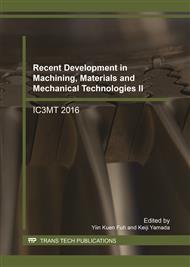p.76
p.81
p.87
p.94
p.101
p.107
p.111
p.118
p.124
Turning of Titanium Alloy Using Near-Dry Methods with MQL, Coolant Mist and Hybrid Mist Supplies
Abstract:
Because of effective machining operations with a very small amount of cutting fluids, near-dry machining attracts increasing attentions for environmental and economical benefits. MQL machining has so far been recognized as the most representative near-dry method and it is highly successful in machining of most ordinary steels. Recent concern for environmentally friendly manufacturing further encourages the attempts at applying near-dry operations to machining of difficult-to-cut materials. Since titanium alloys are typical difficult-to-cut materials, this paper investigates the cutting performance of various near-dry methods in turning of a titanium alloy from the view point of elongating the tool life. Those near-dry operations include supply methods of regular MQL mist, coolant mist and hybrid mists, where the coolant mist is atomized water-soluble cutting fluid and hybrid mists are the mixture of MQL and coolant mists. The regular MQL operation provided longer tool life than that of dry machining. In addition, compared with MQL machining, the hybrid mist operations could further extend tool life and, in particular, the single coolant mist operations demonstrated the possibility of making the tool life longer than that of ordinary wet machining with flood cutting fluid supply.
Info:
Periodical:
Pages:
101-106
Citation:
Online since:
August 2017
Authors:
Keywords:
Price:
Сopyright:
© 2017 Trans Tech Publications Ltd. All Rights Reserved
Share:
Citation:


